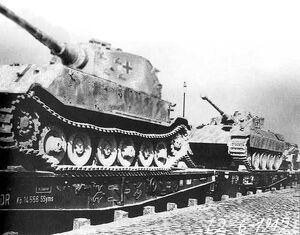| VK4502(P) Ausf B Pzkpfw Tiger 2 Type 180 Ausf B | |
|---|---|

| |
| General Historical Information | |
| Place of origin | Germany |
| Designer | Ferdinand Porsche |
| Manufacturer | Porsche |
| Produced In | Never |
| Category | Heavy Tank |
| Debut in FHSW | v0.51 |
| Speed | 35 km/h |
| Main armament | 8.8 cm KwK 43 L/71 (84 rounds) |
| Coaxial weapon | 7.92 mm MG 42 (150 rounds) |
| General Ingame Information | |
| Used by | Germany |
| Crew in‑game | 4 |
| Seat 2 | 7.92 mm MG 42 (250 rounds) Artillery Spot |
| Seat 3 | 7.92 mm MG 42 (250 rounds) |
| Seat 4 | Nahverteidigungswaffe Artillery Spot |
| Seat 5 | Passenger Seat |
| Seat 6 | Passenger Seat |
| Historical Picture | |

| |
The ingame name, Tiger P2, was given to the Volkettenfahrzeuge 4502(Porsche) Ausf B or abbreviated as VK4502(P) Ausf B. It was an experimental German Heavy Tank designed by Porsche as answer on the request of a new heavy tank, which lead to the Konïgstiger, and was based on his previous design the VK4501(P). The initial concept work for the new Panzer started on the 23rd March 1942 and initially it was proposed that the chassis design for the VK4502(P) could be adopted from the VK4501(P) (which was the prototype for the Tiger and, after cancellation, was the chassis for the Panzerjäger Tiger (P) with very little modification aside from that needed to fit the new Krupp P-2 turret and ammunition stowage.
But, as time went on, views on what was needed on future battlefields caused significant changes to be initiated in armour protection for the tank and it was not until late May, early July, 1942 that the hull design was finalised. The hull design consisted of sloping plates for increased protection, the 80mm glacis plate was sloped at 55 degrees, the 80mm superstructure side plates at 15 degrees, the 80mm hull side plates 0 degrees vertical, 80mm upper tail plate at 60 degrees, 80mm lower tail plate at 25 degrees and 40 to 25mm deck plates at 90 degrees horizontal and 20mm belly plate at 90 degrees horizontal.
The drive train consisted of two Porsche Type 101/3 10 cylinder engines connected to electric generators providing power to a pair of electric motors, one for each sprocket. The running gear and tracks for the VK4502(P) were identical to the VK4501(P) range of tanks. The expected top speed of the tank was 35 km/h and the combat weight was expected to be 45 tonnes. The turret for the VK4502 was also designed by professor Porsche and would mount the 8.8cm Kw.K. L/71. 68 rounds for this gun were carried in the tank 42 in horizontal panniers along the superstructure sides, 10 horizontally on the floor and 16 rounds stored horizontally in the turret.
Production contracts for manufacture were given to Fried Kruppe AG Essen on the 4th of February 1942 for 100 VK4502 armour shells along with 100 turrets. The armour hulls were to be delivered to the Nibelungwerk GmbH, St. Valentin for assembly and the turrets to Fried.Kruppe AG Ruhr for assembly. Kruppe was to begin production of the armour as soon as they completed work for the 100 VK4501 hulls currently under manufacture. On the 17th of April 1942 a verbal extension to this contract would see the number of tanks hulls ordered increased to 200 units with a chassis numbers of 150101 - 150300.
During a visit to Krupp in May 1942 Dr. Porsche was told that the first four hulls would be ready in October instead of August 1942. Also at this time to enhance the ability to modify the hull and their interior components Krupp was ordered only to complete 30 Type 180 Hulls and only prepare plates for the rest.
In July 1942 Krupp contacted the Nibelungenwerk confirming that delivery of the first 30 hulls were expected on time and that material for 50 hulls had already been prepared and, for the most part, rolled out. Krupp estimated a delivery of 15 hulls per months to the Nibelungwerk.
The project however took a serious setback that same month when the Porsche designed 101/3 engine failed during its testing. This lead Wa J Rue on the 3rd of November 1942 to informed Krupp that the contracts for the VK4502 Hulls and turrets were terminated and in its place a separate contract for only three Versuchs-panzers was placed.
A Krupp report dated the 15th of January 1943 reported that 20 Armour turret bodies for the VK4502 had already been manufactured and around 40 to 50 were under construction at the time of cancellation with an additional 50 turrets worth of individual plates available for assembly.
On the 25th January 1943 permission was given to Krupp to assemble three operational turrets for the VK 4502. A further report sent this time from Krupp on the 28th January reported that the three hulls for the VK4502 had been delivered to the Nibelungwerk. This was confirmed by a letter from Dr Porsche dated 17th February 1943 stating that three Tiger P2 VK4502 with electric drives are being completed at the Nibelungwerk. The letter goes on to state that production vehicles would feature new hydraulic drives, a new suspension system and an air-cooled diesel engine.
Nothing more is heard about the fate of the VK4502 until 25th April 1944 when Krupp reported that one of the turrets for the tank was completed and the other two were close to completion. Then on the 22nd of August 1944 at the request of Wa Pruef 6 the remaining turrets were converted for use on the Henschel chassis.
Combat?[]
By the spring of 1945 Germany had become a battleground. At the Wehrmacht weapons testing grounds, at Kummersdorf, the various test departments began evacuating important materials and documents and burning the rest. At the beginning of March 1945 the "Kummersdorf Panzer Battalion" was formed from elements of the Technischen Versuchs Kompanie "Technical Test Company" it had a mixed complement of vehicles. On the 14 March 1945, part of the panzer battalion Kummersdorf was absorbed into I./Panzer-Regiment 29 which was part of the newly formed Panzer-Division "Muncheberg" a division which itself was formed on the 5th of March 1945. An OKH order dated 18 April 1945 shows that the Kummersdorf Abteilung and the 1/29 Panzer Regiment were organized into an ad-hoc regiment.
The Kummersdorf or 1st battalion had a staff, a staff company, a Tiger Company (formerly 3/Kummersdorf Panzer Battalion), a Panther company, a mixed Panzer company, and a supply company. The Inspector-General of Armoured Forces mentioned the formation of Kummersdorf panzer company new unit, formed out of the logistics battalion at Kummersdorf. during the course of a briefing at Fuhrer Headquarters on 31 March 1945. It was organised into three tank platoons (partially mobile), one armoured reconnaissance platoon (not mobile). The vehicles were taken from those kept on hand for test purposes. They included a Panzer VI Tiger II (Sd.Kfz. 182), a Jagdtiger, two American Sherman tanks, an Italian P 40(i) tank, and several B IV heavy explosive charge carriers armed with machine guns, one Tiger II, one Jagdtiger, four Panthers, two Panzer N, one Panzer III, one Nashorn, one Hummel, two Sherman's, and one immobile Porsche Tiger 8.8-centimeter L/70 main gun.
According to a priority telex message dated 4 April 1945, at least part of the panzer company was supposed to be transferred into the Dresden area. A report on the 19 April 1945 stated the Kummersdorf panzer company was on the march to Luchau. A final report dated 21 April 1945 stated the battalion staff and the company had been attached to Kampfgruppe MOWS. The non-mobile elements of Kummersdorf panzer company, including a Tiger tank with the Porsche turret Porsche Tiger 8.8-centimeter L/70 main gun saw action at the end of April in the fighting south east of the proving ground. Another tank unit was formed at Kummersdorf using the civilian drivers, including Behnisch, whose name appears several times. According to a note dated 21 April 1945, this unit was supposed to go into action south of Zossen as part of Kampfgruppe Kaether. With a total of 42 vehicles, including at least one Panzer V Panther, it set out in the direction of Baruth. Troops of the 1st Ukrainian Front advancing from Golssen had to be held up. A battle developed near Baruth in which the makeshift tank unit was completely wiped out. At Kummersdorf the battle commander of Kummersdorf put together a Volkssturm unit from the remaining men. It saw action on the road to Horstwalde. A damaged Tiger was hauled out of the garages of the Verskraft to bolster its strength. There was a brief exchange of fire with red army troops during which a T34 was knocked out. Fighting was also recorded in the area of the army workers settlement, where 88-mm anti-aircraft guns destroyed another tank. Members of the Volkssturm wielding Panzerfaust anti-tank weapons destroyed several Russian tanks. (Approximately 3km East of Horstwalde village) The defensive ring around Kummersdorf, which had been broken in several places, disintegrated.
Sources[]
- Henk of Holland Models
| |||||||||||||||||||||||||||||












